Isolation, Identification, and Characterization of Novel Environmental Bacteria with Polyurethane-Degrading Activity
Simple Summary
Abstract
1. Introduction
2. Materials and Methods
2.1. Culture Media
2.2. Polyurethane Foams Synthesis
2.3. Isolation of PU Biodegrading Bacteria
2.4. Identification of Isolated Bacteria
2.5. Quantitative DLN Biodegradation Analysis
2.6. Enzymatic Analysis
2.7. FPU Biodegradation Assay
3. Results
3.1. Direct Screening of PU Biodegrading Bacteria
3.2. Bacteria Identification
3.3. Quantitative PU Biodegradation Analysis
3.4. Enzymatic Analysis
3.5. FPU Biodegradation
4. Discussion
5. Conclusions
Author Contributions
Funding
Institutional Review Board Statement
Data Availability Statement
Acknowledgments
Conflicts of Interest
References
- Pilapitiya, P.G.C.N.T.; Ratnayake, A.S. The world of plastic waste: A review. Clean. Mater. 2024, 11, 100220. [Google Scholar] [CrossRef]
- Rodrigues, M.O.; Abrantes, N.; Gonçalves, F.J.M.; Nogueira, H.; Marques, J.C.; Gonçalves, A.M.M. Impacts of plastic products used in daily life on the environment and human health: What is known? Environ. Toxicol. Pharmacol. 2019, 72, 103239. [Google Scholar] [CrossRef]
- Gautam, R.; Bassi, A.S.; Yanful, E.K. A review of biodegradation of synthetic plastic and foams. Appl. Biochem. Biotechnol. 2007, 141, 85–108. [Google Scholar] [CrossRef]
- Liu, J.; He, J.; Xue, R.; Xu, B.; Qian, X.; Xin, F.; Blank, L.M.; Zhou, J.; Wei, R.; Dong, W.; et al. Biodegradation and up-cycling of polyurethanes: Progress, challenges, and prospects. Biotechnol. Adv. 2021, 48, 107730. [Google Scholar] [CrossRef]
- Statista. Market Volume of Polyurethane Worldwide from 2015 to 2025, with a Forecast for 2022 to 2029. 2025. Available online: https://www.statista.com/statistics/720341/global-polyurethane-market-size-forecast/ (accessed on 19 March 2025).
- Debuissy, T.; Pollet, E.; Avérous, L. Synthesis and characterization of fully biobased poly(propylene succinate-ran-propylene adipate). Analysis of the architecture-dependent physicochemical behavior. J. Polym. Sci. Polym. Chem. 2017, 55, 2738–2748. [Google Scholar] [CrossRef]
- Magnin, A.; Pollet, E.; Phalip, V.; Avérous, L. Evaluation of biological degradation of polyurethanes. Biotechnol. Adv. 2020, 39, 107457. [Google Scholar] [CrossRef] [PubMed]
- Skleničková, K.; Abbrent, S.; Halecký, M.; Kočí, V.; Beneš, H. Biodegradability and ecotoxicity of polyurethane foams: A review. Crit. Rev. Environ. Sci. Technol. 2020, 50, 157–202. [Google Scholar] [CrossRef]
- Howard, G.T. Polyurethane biodegradation. In Microbial Degradation of Xenobiotics; Singh, S.N., Ed.; Springer: Berlin/Heidelberg, Germany, 2012; pp. 189–211. [Google Scholar] [CrossRef]
- Mahajan, N.; Gupta, P. New insights into the microbial degradation of polyurethanes. RSC Adv. 2015, 5, 41839–41854. [Google Scholar] [CrossRef]
- Lucas, N.; Bienaime, C.; Belloy, C.; Queneudec, M.; Silvestre, F.; Nava-Saucedo, J.E. Polymer biodegradation: Mechanisms and estimation techniques. Chemosphere 2008, 73, 429–442. [Google Scholar] [CrossRef] [PubMed]
- Shah, A.A.; Hasan, F.; Hameed, A.; Ahmed, S. Biological degradation of plastics: A comprehensive review. Biotechnol. Adv. 2008, 26, 246–265. [Google Scholar] [CrossRef]
- Wierckx, N.; Narancic, T.; Eberlein, C.; Wei, R.; Drzyzga, O.; Magnin, A.; Ballerstedt, H.; Kenny, S.T.; Pollet, E.; Averous, L. Plastic biodegradation: Challenges and opportunities, consequences of microbial interactions with hydrocarbons, oils, and lipids. J. Bioremediat. Biodegrad. 2018, 9, 333–361. [Google Scholar] [CrossRef]
- Zeng, S.H.; Duan, P.P.; Shen, M.X.; Xue, Y.J.; Wang, Z.Y. Preparation and mechanisms of biodegradable polymer: A review. IOP Conf. Ser. Mater. Sci. Eng. 2016, 137, 012003. [Google Scholar] [CrossRef]
- Nakajima-Kambe, T.; Onuma, F.; Kimpara, N.; Nakahara, T. Isolation and characterization of a bacterium which utilizes polyester polyurethane as a sole carbon and nitrogen source. FEMS Microbiol. Lett. 1995, 129, 39–42. [Google Scholar] [CrossRef]
- Shah, Z.; Gulzar, M.; Hasan, F.; Shah, A.A. Degradation of polyester polyurethane by an indigenously developed consortium of Pseudomonas and Bacillus species isolated from soil. Polym. Degrad. Stab. 2016, 134, 349–356. [Google Scholar] [CrossRef]
- Gui, Z.; Liu, G.; Liu, X.; Cai, R.; Liu, R.; Sun, C. A deep-sea bacterium is capable of degrading polyurethane. Microbiol. Spectr. 2023, 11, e0007323. [Google Scholar] [CrossRef]
- Ji, J.; Pei, J.; Ding, F.; Zeng, C.; Zhou, J.; Dong, W.; Cui, Z.; Yan, X. Isolation and characterization of polyester polyurethane-degrading bacterium Bacillus sp. YXP1. Environ. Res. 2024, 249, 118468. [Google Scholar] [CrossRef] [PubMed]
- Peng, Y.H.; Shih, Y.H.; Lai, Y.C.; Liu, Y.Z.; Liu, Y.T.; Lin, N.C. Degradation of polyurethane by bacterium isolated from soil and assessment of polyurethanolytic activity of a Pseudomonas putida strain. Environ. Sci. Pollut. Res. 2014, 21, 9529–9537. [Google Scholar] [CrossRef]
- Kim, J.-H.; Choi, S.H.; Park, M.G.; Park, D.H.; Son, K.-H.; Park, H.-Y. Polyurethane biodegradation by Serratia sp. HY_72 isolated from the intestine of Asian mantis Hierodula patellifera. Front. Microbiol. 2022, 13, 10005415. [Google Scholar] [CrossRef] [PubMed]
- Pantelic, B.; Siaperas, R.; Budin, C.; de Boer, T.; Topakas, E.; Nikodinovic-Runic, J. Proteomic examination of polyester-polyurethane degradation by Streptomyces sp. PU10: Diverting polyurethane intermediates to secondary metabolite production. Microb. Biotechnol. 2024, 17, 14445. [Google Scholar] [CrossRef]
- Maheswaran, B.; Raj, J.S.; Pandiyarajan, P.; Santhi, R.J.; Mythili, R.; Vignesh, K.S.; Kim, W.; Karmegam, N.; Govarthanan, M. Polyurethane degradation by extracellular urethanase producing bacterial isolate Moraxella catarrhalis strain BMPPS3. Environ. Res. 2024, 251, 118631. [Google Scholar] [CrossRef] [PubMed]
- Zeng, J.; Yao, J.; Zhang, W.; Zhang, M.; Wang, T.; Yu, X.; Liu, Y.; Sun, X.; Li, L. Biodegradation of commercial polyester polyurethane by a soil-borne bacterium Bacillus velezensis MB01B: Efficiency, degradation pathway, and in-situ remediation in landfill soil. Environ. Pollut. 2024, 363, 125300. [Google Scholar] [CrossRef]
- Alvarez-Barragán, J.; Domínguez-Malfavón, L.; Vargas-Suárez, M.; González-Hernández, R.; Aguilar-Osorio, G.; Loza-Tavera, H. Biodegradative activities of selected environmental fungi on a polyester polyurethane varnish and polyether polyurethane foams. Appl. Environ. Microbiol. 2016, 82, 5225–5235. [Google Scholar] [CrossRef]
- Liu, J.; Zeng, Q.; Lei, H.; Xin, K.; Xu, A.; Wei, R.; Li, Y.; Zhou, J.; Dong, W.; Jiang, M. Biodegradation of polyester polyurethane by Cladosporium sp. P7: Evaluating its degradation capacity and metabolic pathways. J. Hazard. Mater. 2023, 448, 13776. [Google Scholar] [CrossRef]
- Oceguera-Cervantes, A.; Carrillo-García, A.; López, N.; Bolaños-Nuñez, S.; Cruz-Gómez, M.J.; Wacher, C.; Loza-Tavera, H. Characterization of the polyurethanolytic activity of two Alicycliphilus sp. strains able to degrade polyurethane and N-methylpyrrolidone. Appl. Environ. Microbiol. 2007, 73, 6214–6223. [Google Scholar] [CrossRef]
- Maier, T.; Klepel, S.; Renner, U.; Kostrzewa, M. Fast and reliable MALDI-TOF MS-based microorganism identification. Nat. Methods 2006, 3, i–ii. [Google Scholar] [CrossRef]
- Arahal, D.R.; Sánchez, E.; Macián, M.C.; Garay, E. Value of recN sequences for species identification and as a phylogenetic marker within the family “Leuconostocaceae”. Int. Microbiol. 2008, 11, 33–39. [Google Scholar] [PubMed]
- Altschul, S.F.; Madden, T.L.; Schäffer, A.A.; Zhang, J.; Zhang, Z.; Miller, W.; Lipman, D.J. Gapped BLAST and PSI-BLAST: A new generation of protein database search programs. Nucleic Acids Res. 1997, 25, 3389–3402. [Google Scholar] [CrossRef] [PubMed]
- Howard, G.T.; Blake, R.C. Growth of Pseudomonas chlororaphis on a polyester–polyurethane and the purification and characterization of a polyurethanase–protease enzyme. Int. Biodeterior. Biodegrad. 1998, 42, 213–220. [Google Scholar] [CrossRef]
- Christensen, W.B. Urea decomposition as a means of differentiating Proteus and paracolon cultures from each other and from Salmonella and Shigella types. J. Bacteriol. 1946, 52, 461–466. [Google Scholar] [CrossRef] [PubMed]
- Sierra, G. A simple method for the detection of lipolytic activity of microorganisms and some observations on the influence of the contact between cells and fatty substrates. Antonie Van Leeuwenhoek 1957, 23, 15–22. [Google Scholar] [CrossRef]
- Ciric, M.; Šaraba, V.; Budin, C.; de Boer, R.; Nikodinovic-Runic, J. Polyurethane-Degrading Potential of Alkaline Groundwater Bacteria. Microb. Ecol. 2023, 87, 21. [Google Scholar] [CrossRef]
- Giyahchi, M.; Moghimi, H. Aerobic biodegradation of untreated polyester–polyether urethanes by newly isolated yeast strains Exophilia sp. NS-7 and Rhodotorula sp. NS-12. Sci. Rep. 2023, 13, 5016. [Google Scholar] [CrossRef]
- Veloso, L.; da Silva, R.V.; Moura, C.; de Andrade, J.M.; Ventura, F.; Marques, A.; Louro, E.; Nunes, J.; Lima, M.L.; Viana, V. MALDI-TOF MS database expansion for identification of Bacillus and related genera isolated from a pharmaceutical facility. J. Microbiol. Methods 2022, 203, 106625. [Google Scholar] [CrossRef]
- Ashfaq, M.Y.; Da’na, D.A.; Al-Ghouti, M.A. Application of MALDI-TOF MS for identification of environmental bacteria: A review. J. Environ. Manag. 2022, 305, 114359. [Google Scholar] [CrossRef]
- Durán-Viseras, A.; Castro, D.J.; Reina, J.C.; Béjar, V.; Martínez-Checa, F. Taxogenomic and Metabolic Insights into Marinobacterium ramblicola sp. nov., a New Slightly Halophilic Bacterium Isolated from Rambla Salada, Murcia. Microorganisms 2021, 9, 1654. [Google Scholar] [CrossRef] [PubMed]
- Gao, Y.; Zhu, H.; Wang, J.; Shao, Z.; Wei, S.; Wang, R.; Cheng, R.; Jiang, L. Physiological and Genomic Characterization of a Novel Obligately Chemolithoautotrophic, Sulfur-Oxidizing Bacterium of Genus Thiomicrorhabdus Isolated from a Coastal Sediment. Microorganisms 2023, 11, 2569. [Google Scholar] [CrossRef] [PubMed]
- Nakajima-Kambe, T.; Onuma, F.; Akutsu, Y.; Nakahara, T. Determination of the polyester polyurethane breakdown products and distribution of the polyurethane degrading enzyme of Comamonas acidovorans strain TB-35. J. Ferment. Bioeng. 1997, 83, 456–460. [Google Scholar] [CrossRef]
- Schmidt, J.; Wei, R.; Oeser, T.; Dedavid e Silva, L.A.; Breite, D.; Schulze, A.; Zimmermann, W. Degradation of polyester polyurethane by bacterial polyester hydrolases. Polymers 2017, 9, 65. [Google Scholar] [CrossRef]
- Akutsu, Y.; Nakajima-Kambe, T.; Nomura, N.; Nakahara, T. Purification and properties of a polyester polyurethane-degrading enzyme from Comamonas acidovorans TB-35. Appl. Environ. Microbiol. 1998, 64, 62–67. [Google Scholar] [CrossRef]
- Blake, R.C.; Howard, G.T. Adherence and growth of a Bacillus species on an insoluble polyester polyurethane. Int. Biodeterior. Biodegrad. 1998, 42, 63–73. [Google Scholar] [CrossRef]
- Rowe, L.; Howard, G.T. Growth of Bacillus subtilis on polyurethane and the purification and characterization of a polyurethanase-lipase enzyme. Int. Biodeterior. Biodegrad. 2002, 50, 33–40. [Google Scholar] [CrossRef]
- Abdelhaleem, H.A.R.; Zein, H.S.; Azeiz, A.; Sharaf, A.N.; Abdelhadi, A.A. Identification and characterization of novel bacterial polyaromatic hydrocarbon-degrading enzymes as potential tools for cleaning up hydrocarbon pollutants from different environmental sources. Environ. Toxicol. Pharmacol. 2009, 67, 108–116. [Google Scholar] [CrossRef] [PubMed]
- Jebashalomi, V.; Emmanuel Charles, P.; Rajaram, R. Microbial degradation of low-density polyethylene (LDPE) and polystyrene using Bacillus cereus (OR268710) isolated from plastic-polluted tropical coastal environment. Sci. Total Environ. 2024, 924, 171580. [Google Scholar] [CrossRef]
- Akash, K.; Parthasarathi, R.; Elango, R.; Bragadeeswaran, S. Characterization of Priestia megaterium S1, a polymer degrading gut microbe isolated from the gut of Tenebrio molitor larvae fed on Styrofoam. Arch. Microbiol. 2024, 206, 48. [Google Scholar] [CrossRef]
- Gupta, K.K.; Sharma, K.K.; Chandra, H. Utilization of Bacillus cereus strain CGK5 associated with cow feces in the degradation of commercially available high-density polyethylene (HDPE). Arch. Microbiol. 2023, 205, 101. [Google Scholar] [CrossRef]
- Gaytán, I.; Sánchez-Reyes, A.; Burelo, M.; Vargas-Suárez, M.; Liachko, I.; Press, M.; Sullivan, S.; Cruz-Gómez, M.J.; Loza-Tavera, H. Degradation of recalcitrant polyurethane and xenobiotic additives by a selected landfill microbial community and its biodegradative potential revealed by proximity ligation-based metagenomic analysis. Front. Microbiol. 2020, 10, 2986. [Google Scholar] [CrossRef]
- Das, G.; Bordoloi, N.K.; Rai, S.K.; Mukherjee, A.K.; Karak, N. Biodegradable and biocompatible epoxidized vegetable oil modified thermostable poly(vinyl chloride): Thermal and performance characteristics post biodegradation with Pseudomonas aeruginosa and Achromobacter sp. J. Hazard. Mater. 2012, 209, 434–442. [Google Scholar] [CrossRef] [PubMed]
- Bai, N.; Li, S.; Zhang, J.; Zhang, H.; Zhang, H.; Zheng, X.; Lu, W. Efficient biodegradation of DEHP by CM9 consortium and shifts in the bacterial community structure during bioremediation of contaminated soil. Environ. Pollut. 2020, 266, 115112. [Google Scholar] [CrossRef]
- Zhang, L.; Cao, K.; Liu, H.; Wang, Y.; Zhang, B.; Han, H.; Cui, Z.; Cao, H. Discovery of a polyester polyurethane-degrading bacterium from a coastal mudflat and identification of its degrading enzyme. J. Hazard. Mater. 2025, 483, 136659. [Google Scholar] [CrossRef]
- Chhetri, G.; Jeon, J.-M.; Hwang, G.; Choi, T.-R.; Yang, Y.-H.; Cha, C.-J.; Yoon, J.-J. Biodegradation of PCL, PBS, and PBAT at low temperatures by Aeromicrobium sp. JJY06: A newly isolated strain for cold-environment plastic cleanup. J. Hazard. Mater. 2025, 495, 138896. [Google Scholar] [CrossRef] [PubMed]
- Quek, E.; Ting, Y.P.; Tan, H.M. Rhodococcus sp. F92 immobilized on polyurethane foam shows ability to degrade various petroleum products. Bioresour. Technol. 2005, 97, 32–38. [Google Scholar] [CrossRef]
- Akutsu-Shigeno, Y.; Adachi, Y.; Yamada, C.; Toyoshima, K.; Nomura, N.; Uchiyama, H.; Nakajima-Kambe, T. Isolation of a bacterium that degrades urethane compounds and characterization of its urethane hydrolase. Appl. Microbiol. Biotechnol. 2006, 70, 422–429. [Google Scholar] [CrossRef]
- Orts, J.M.; Naranjo, E.; Pina, S.; Orts, A.; Muñoz-Martí, M.; Tejada, M.; Parrado, J. Polyurethane waste valorization: A two-phase process using ozonization and Rhodococcus pyridinivorans fermentation for biofertilizer production. Bioresour. Technol. 2025, 416, 131814. [Google Scholar] [CrossRef]
- Su, T.; Zhang, T.; Liu, P.; Bian, J.; Zheng, Y.; Yuan, Y.; Li, Q.; Liang, Q.; Qi, Q. Biodegradation of polyurethane by the microbial consortia enriched from landfill. Appl. Microbiol. Biotechnol. 2023, 107, 1983–1995. [Google Scholar] [CrossRef]
- Akkoyunlu, B.; Gabarre, C.; Daly, S.; Casey, E.; Syron, E. Process modelling for industrial scale polyhydroxybutyrate production using fructose, formic acid and CO2: Assessing carbon sources and economic viability. Bioresour. Technol. 2024, 393, 130139. [Google Scholar] [CrossRef]
- Wei, S.; Zhao, Y.; Zhou, R.; Lin, J.; Su, T.; Tong, H.; Wang, Z. Biodegradation of polybutylene adipate-co-terephthalate by Priestia megaterium, Pseudomonas mendocina, and Pseudomonas pseudoalcaligenes following incubation in the soil. Chemosphere 2022, 307, 135700. [Google Scholar] [CrossRef] [PubMed]
- Akash, K.; Parthasarathi, R.; Elango, R.; Bragadeeswaran, S. Exploring the intricate studies on low-density polyethylene (LDPE) biodegradation by Bacillus cereus AP-01, isolated from the gut of Styrofoam-fed Tenebrio molitor larvae. Biodegradation 2025, 36, 12. [Google Scholar] [CrossRef] [PubMed]
- Biedendieck, R.; Knuuti, T.; Moore, S.J.; Jahn, D. The “beauty in the beast”—The multiple uses of Priestia megaterium in biotechnology. Appl. Microbiol. Biotechnol. 2021, 105, 5719–5737. [Google Scholar] [CrossRef] [PubMed]
- Patel, B.P.; Kumar, A. Optimization study for maximizing 2,4-dichlorophenol degradation by Kocuria rhizophila strain using response surface methodology and kinetic study. Desalin. Water Treat. 2016, 57, 18314–18325. [Google Scholar] [CrossRef]
- Parshetti, G.K.; Telke, A.A.; Kalyani, D.C.; Govindwar, S.P. Decolorization and detoxification of sulfonated azo dye methyl orange by Kocuria rosea MTCC 1532. J. Hazard. Mater. 2010, 176, 503–509. [Google Scholar] [CrossRef]
- Ezima, E.N.; Awotula, A.O.; Adegbesan, B.O.; Osonuga, I.O.; Agu, G.C.; Adesanya, E.O.; Odufuwa, K.T.; Fagbohunka, B.S. Biodegradation of naphthalene using Kocuria rosea isolated from a sawmill in Ikenne, Southwestern Nigeria. Pure Appl. Chem. 2024, 96, 1375–1381. [Google Scholar] [CrossRef]
- Afridi, M.S.; Van Hamme, J.D.; Bundschuh, J.; Sumaira; Khan, M.N.; Salam, A.; Waqar, M.; Munis, M.F.H.; Chaudhary, H.J. Biotechnological approaches in agriculture and environmental management -bacterium Kocuria rhizophila 14ASP as heavy metal and salt- tolerant plant growth- promoting strain. Biologia 2021, 76, 3091–3105. [Google Scholar] [CrossRef]
- Hassouna, M.E.K.M.; Abdel-Tawab, M.S.; Abdel-Aleem, A.A.M. Use of biokaolinite clay for the microbial removal of phenol from real industrial wastewater samples by Dermacoccus nishinomiyaensis and Kocuria rosea. Environ. Qual. Manag. 2024, 34, e22181. [Google Scholar] [CrossRef]
- Qi, Y.; Zheng, C.L.; Zhang, Y.T. Microbial degradation of nitrobenzene by immobilized cells of Micrococcus luteus. Adv. Mater. Res. 2012, 599, 52–59. [Google Scholar] [CrossRef]
- Huang, J.; Yang, C.; Zhang, X.; Chen, R.; Hu, S.; Pan, D.; Wu, X. Isolation of Micrococcus sp. strain 2A from the ocean and its biodegradation of 1-naphthol in wastewater. Int. Biodeter. Biodegrad. 2024, 192, 105815. [Google Scholar] [CrossRef]
- Mohanrasu, K.; Rao, R.G.R.; Dinesh, G.H.; Zhang, K.; Sudhakar, M.; Pugazhendhi, A.; Arun, A. Production and characterization of biodegradable polyhydroxybutyrate by Micrococcus luteus isolated from marine environment. Int. J. Biolog. Macromol. 2021, 186, 125–134. [Google Scholar] [CrossRef]
- Naloka, K.; Kuntaveesuk, A.; Muangchinda, C.; Chavanich, S.; Viyakarn, V.; Chen, B.; Pinyakong, O. Pseudomonas and Pseudarthrobacter are the key players in synergistic phenanthrene biodegradation at low temperatures. Sci. Rep. 2024, 14, 11976. [Google Scholar] [CrossRef]
- Chen, F.; Chen, Y.; Chen, C.; Feng, L.; Dong, Y.; Chen, J.; Lan, J.; Hou, H. High-efficiency degradation of phthalic acid esters (PAEs) by Pseudarthrobacter defluvii E5: Performance, degradative pathway, and key genes. Sci. Tot. Environ. 2021, 794, 148719. [Google Scholar] [CrossRef] [PubMed]
- Lamba, J.; Anand, S.; Dutta, J.; Chatterjee, S.; Nagar, S.; Celin, S.M.; Rai, P.K. Study on aerobic degradation of 2,4,6-trinitrotoluene (TNT) using Pseudarthrobacter chlorophenolicus collected from the contaminated site. Environ. Monit. Assess. 2021, 193, 80. [Google Scholar] [CrossRef] [PubMed]
- Wang, H.; Guan, F.; Zhu, Y.; Pan, Y.; Liu, Q.; Liu, Q.; He, W.; Gong, D.; Tian, J.; Han, D. Biofilm formation promoted biodegradation of polyethylene in Gordonia polyisoprenivorans B251 isolated from bacterial enrichment acclimated by hexadecane for two years. Chemosphere 2023, 344, 140383. [Google Scholar] [CrossRef] [PubMed]
- Drzyzga, O. The strengths and weaknesses of Gordonia: A review of an emerging genus with increasing biotechnological potential. Crit. Rev. Microbiol. 2012, 38, 300–316. [Google Scholar] [CrossRef] [PubMed]
- Franco-Duarte, R.; Černáková, L.; Kadam, S.; Kaushik, K.S.; Salehi, B.; Bevilacqua, A.; Corbo, M.R.; Antolak, H.; Dybka-Stępień, K.; Leszczewicz, M.; et al. Advances in chemical and biological methods to identify microorganisms-from past to present. Microorganisms 2019, 7, 130. [Google Scholar] [CrossRef]
- Contesini, F.J.; Melo, R.R.; Sato, H.H. An overview of Bacillus proteases: From production to application. Crit. Rev. Biotechnol. 2018, 38, 321–334. [Google Scholar] [CrossRef] [PubMed]
- Wang, P.; Gao, J.; Zhao, Y.; Zhang, M.; Zhou, S. Biodegradability of di-(2-ethyl-hexyl) phthalate by a newly isolated bacterium Achromobacter sp. RX. Sci. Total Environ. 2021, 755, 142476. [Google Scholar] [CrossRef]
- El-Kurdi, N.; El-Shatoury, S.; ElBaghdady, K.; Hammad, S.; Ghazy, M. Biodegradation of polystyrene nanoplastics by Achromobacter xylosoxidans M9 offers a mealworm gut-derived solution for plastic pollution. Arch. Microbiol. 2024, 206, 238. [Google Scholar] [CrossRef] [PubMed]
- Raczyńska, A.; Góra, A.; André, I. An overview on polyurethane-degrading enzymes. Biot. Adv. 2024, 77, 108439. [Google Scholar] [CrossRef]
- Biffinger, J.C.; Barlow, D.E.; Cockrell, A.L.; Cusick, K.D.; Hervey, W.J.; Fitzgerald, L.A.; Nadeau, L.J.; Hung, C.S.; Crookes-Goodson, W.J.; Russell, J.N. The applicability of Impranil®® DLN for gauging the biodegradation of polyurethanes. Polym. Degrad. Stab. 2015, 120, 178–185. [Google Scholar] [CrossRef]
- Gautam, R.; Bassi, A.S.; Yanful, E.K. Candida rugosa lipase-catalyzed polyurethane degradation in aqueous medium. Biotechnol Lett. 2007, 29, 1081–1086. [Google Scholar] [CrossRef]
- Christenson, E.M.; Patel, S.; Anderson, J.M.; Hiltner, A. Enzymatic degradation of poly(ether urethane) and poly(carbonate urethane) by cholesterol esterase. Biomaterials 2006, 27, 3920–3926. [Google Scholar] [CrossRef]
- Matsumiya, Y.; Murata, N.; Tanabe, E.; Kubota, K.; Kubo, M. Isolation and characterization of an ether-type polyurethane-degrading micro-organism and analysis of degradation mechanism by Alternaria sp. J. Appl. Microbiol. 2010, 108, 1946–1953. [Google Scholar] [CrossRef]
- Loredo-Treviño, A.; Gutiérrez-Sánchez, G.; Rodríguez-Herrera, R.; Aguilar, C.N. Microbial enzymes involved in polyurethane biodegradation: A review. J. Polym. Environ. 2012, 20, 258–265. [Google Scholar] [CrossRef]
- Marova, I.; Obruca, S.; Ondruska, V.; Hrdlickova, J.; David, J.; Vojtova, L.; Jancar, J. Biodegradation of polyurethane foams modified by carboxymethyl cellulose by several bacteria. J. Biotechnol. 2007, 131 (Suppl. 2), S170–S171. [Google Scholar] [CrossRef]
- Kemona, A.; Piotrowska, M. Microorganisms potentially useful in the management of polyurethane foam waste. Infrastrukt. I Ekol. Teren. Wiej. 2016, 2, 1297–1308. [Google Scholar] [CrossRef]
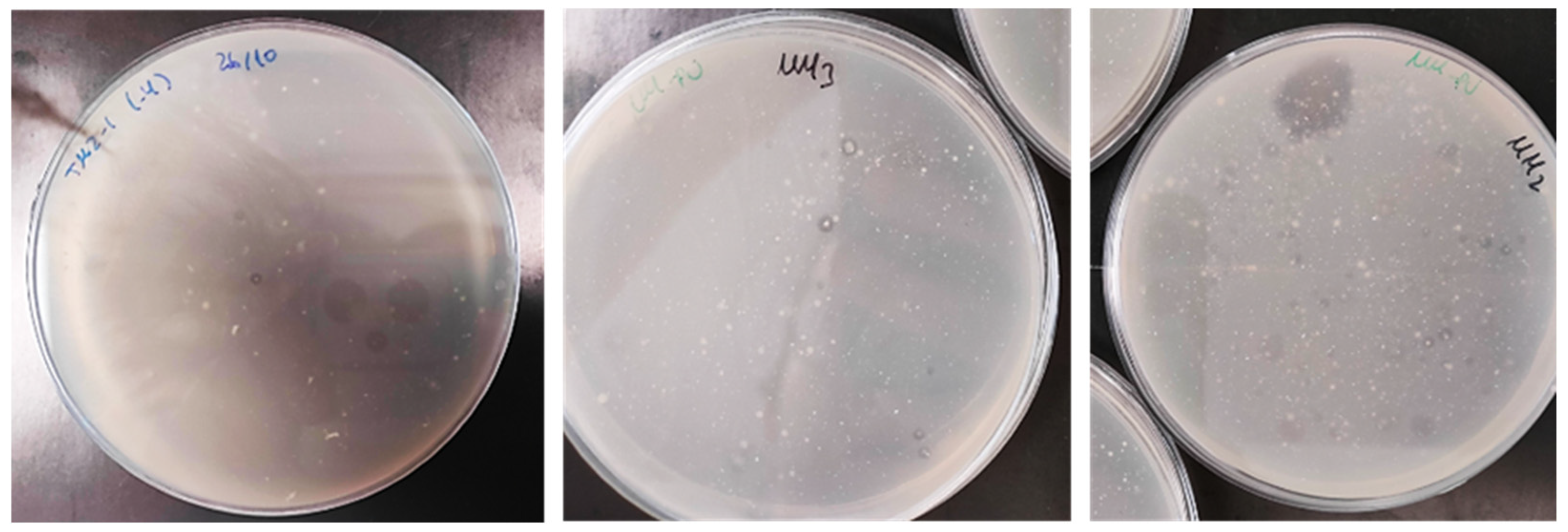

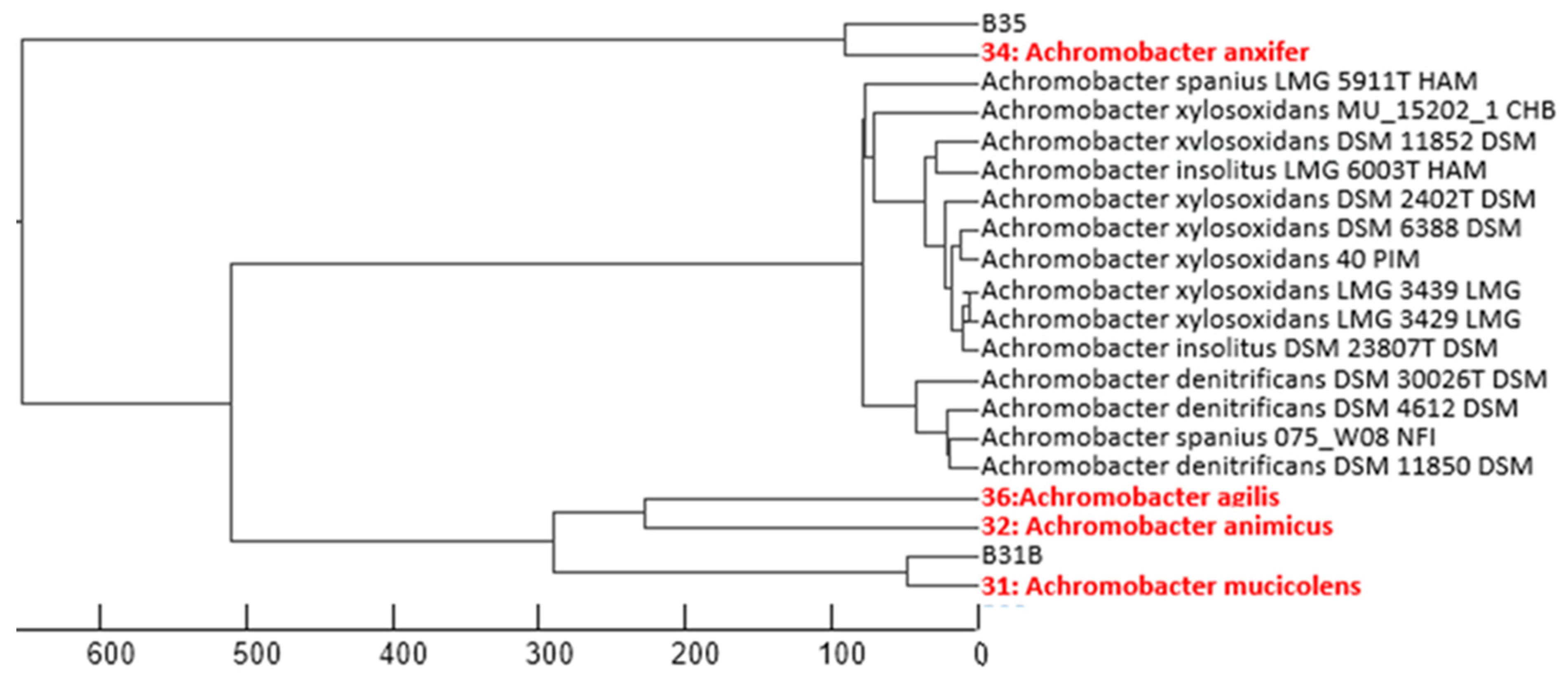
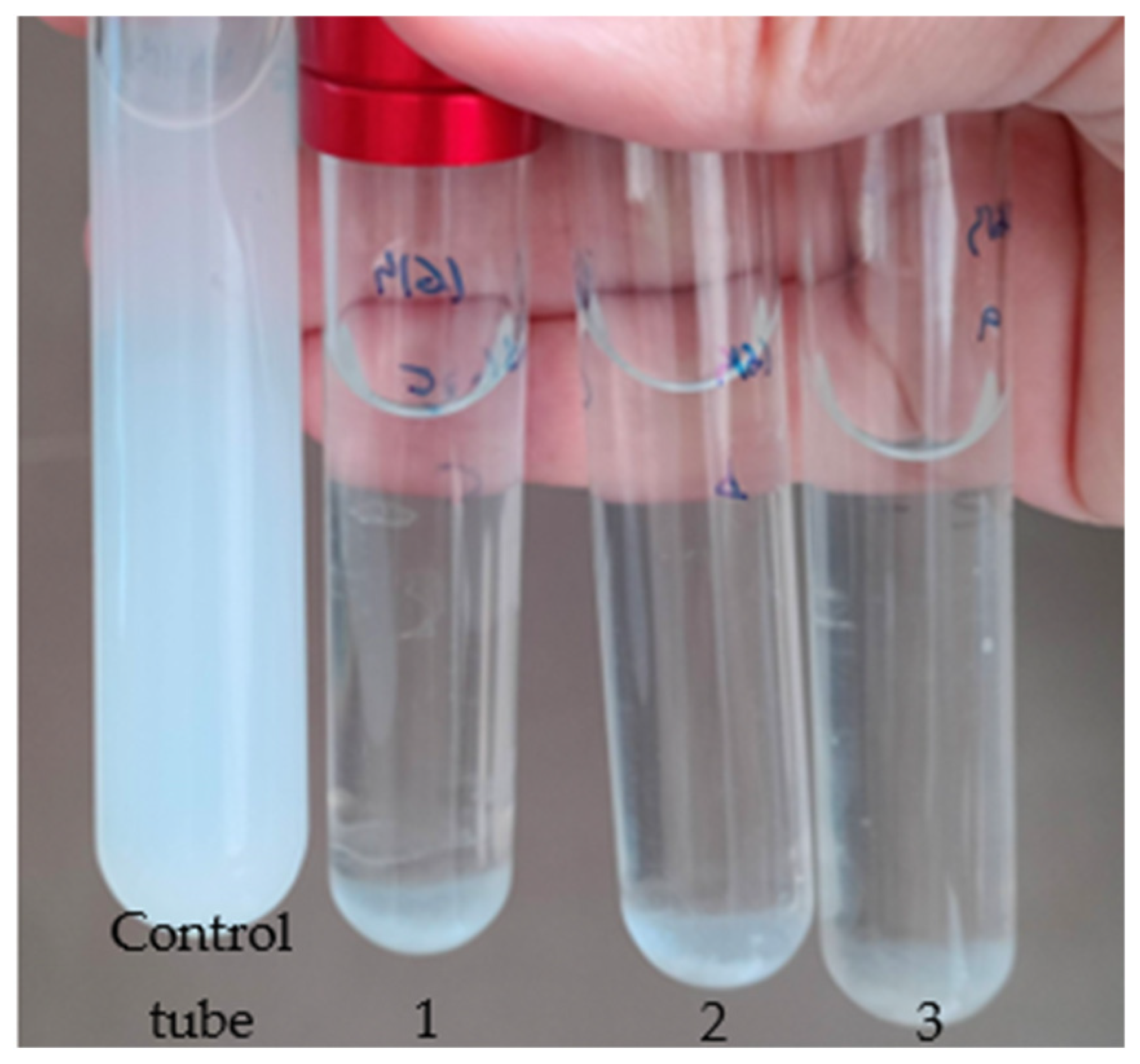


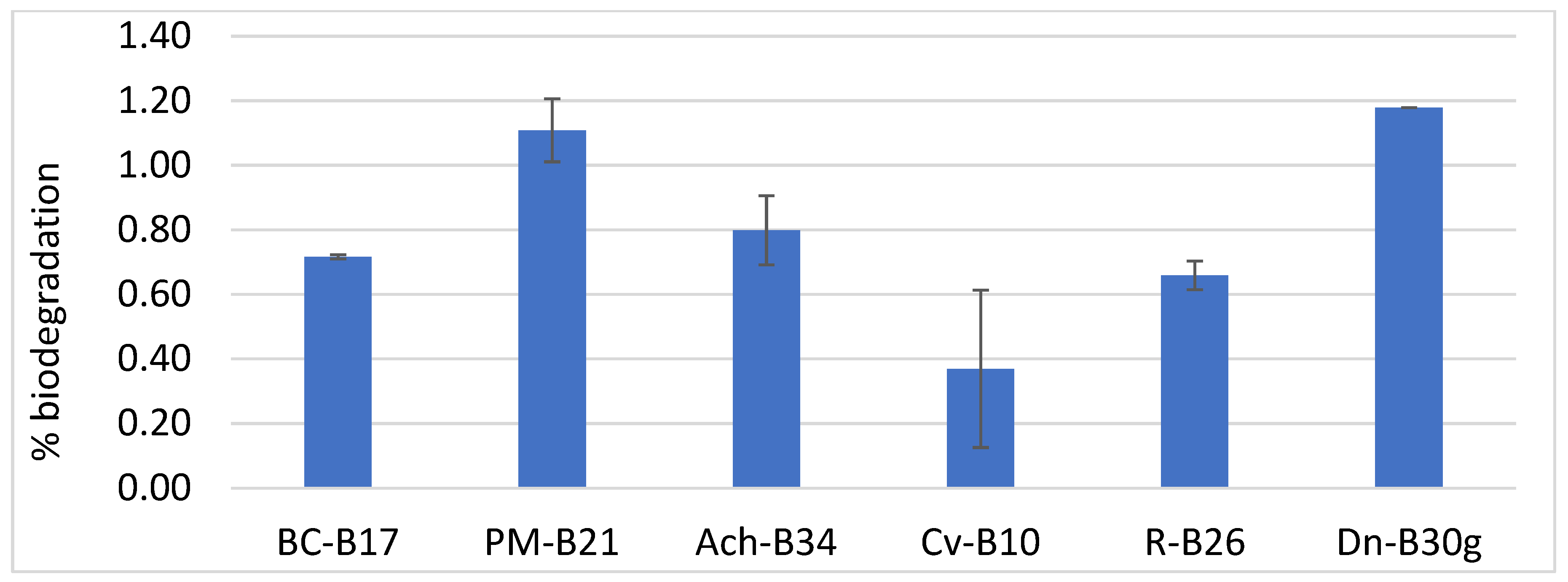
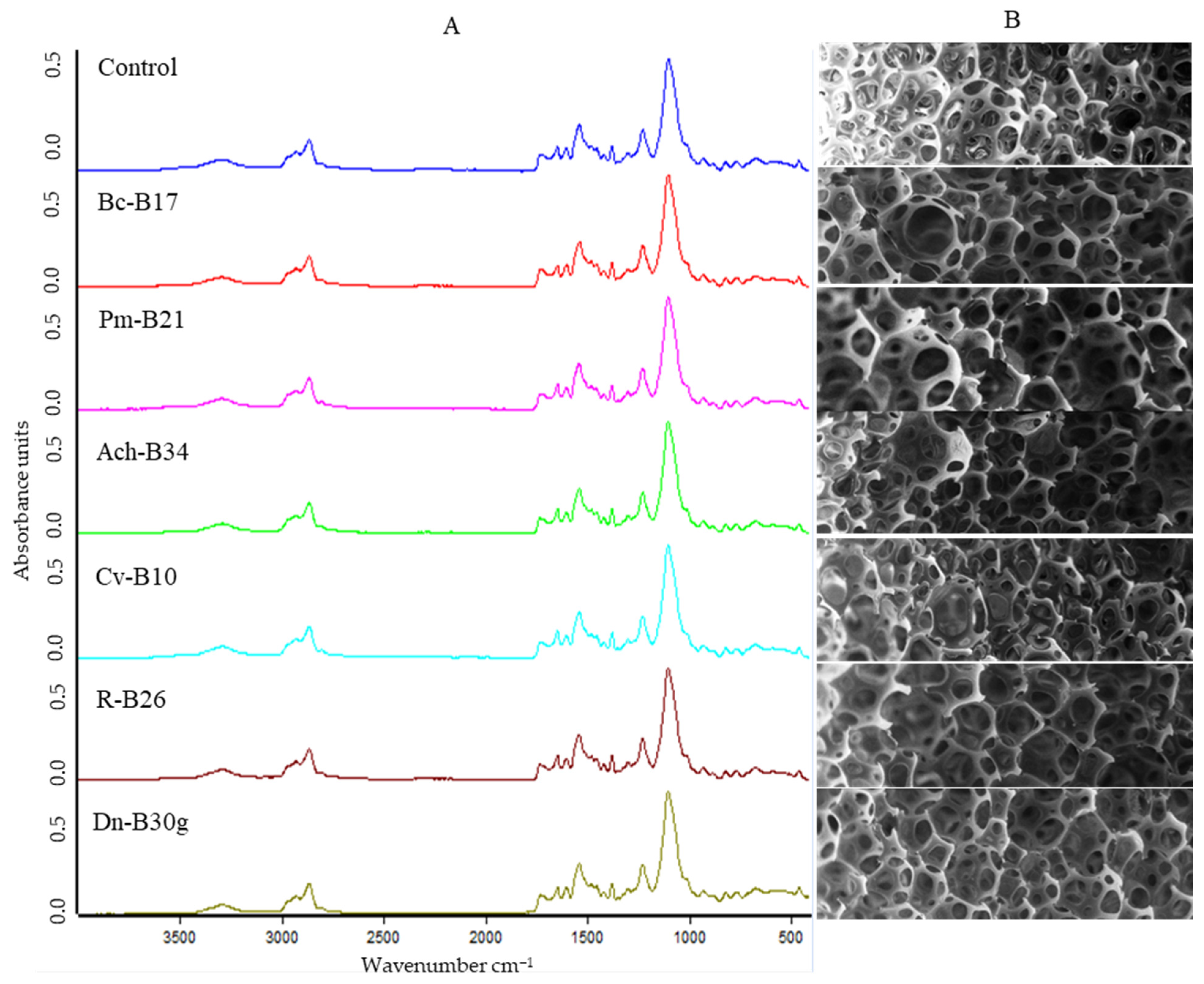
| Isolate | Origin 1 | % Biodegradation 2 |
|---|---|---|
| B1 | TM1 a | 90.1 ± 5.4 |
| B2 | TM2 c | 7.0 ± 6.7 |
| B3 | 82.7 ± 1.0 | |
| B4g | 54.2 ± 7.0 | |
| B5 | 38.8 ± 3.8 | |
| B8 | 12.9 ± 3.0 | |
| B9 | 47.2 ± 8.5 | |
| B10 | 90.1 ± 9.9 | |
| B13 | 33.3 ±8.9 | |
| B15 | 51.4 ± 8.9 | |
| B16 | 32.8 ± 9.9 | |
| B17 | 86.6 ± 9.6 | |
| B18 | 38.1 ± 3.1 | |
| B19 | 46.7± 3.8 | |
| B20 | 84.8 ± 9.0 | |
| B21 | 88.7 ± 2.4 | |
| B22 | 4.7 ± 2.3 | |
| B23 | 82.6 ± 2.9 | |
| B24 | TM3 b,c | 64.0 ± 9.7 |
| B25 | 44.3 ± 7.2 | |
| B26 | TM4 a,b | 89.8 ± 1.6 |
| B30p | 47.0 ± 10.6 | |
| B30g | 72.6 ± 9.2 | |
| B31b | 81.1 ± 6.0 | |
| B31c | 79.7 ± 9.4 | |
| B32 | 74.8 ± 10.1 | |
| B34 | 90.2 ± 4.1 | |
| B35 | 70.1 ± 9.0 | |
| B36t | 81.7 ± 8.6 | |
| B36a | 36.0 ± 2.6 |
| Isolate | Identification | Protease | Urease | Esterase |
|---|---|---|---|---|
| B1 | Bacillus cereus | ++ | + | - |
| B2 | +++ | ++ | - | |
| B3 | +++ | ++ | - | |
| B5 | +++ | + | - | |
| B9 | +++ | ++ | - | |
| B17 | ++ | + | - | |
| B19 | +++ | ++ | - | |
| B20 | ++ | + | - | |
| B22 | +++ | + | - | |
| B24 | + | +++ | + | |
| B4g | Priestia megaterium | + | +++ | - |
| B7 | +++ | +++ | - | |
| B16 | ++ | +++ | - | |
| B21 | +++ | +++ | - | |
| B23 | - | ++ | +++ | |
| B8 | Aeromicrobium sp. | - | - | - |
| B13 | - | - | - | |
| B31b | Achromobacter sp. | + | ++ | + |
| B32 | - | - | ++ | |
| B34 | - | + | ++ | |
| B35 | + | + | + | |
| B36t | + | + | + | |
| B15 | Kocuria rhizophila | ++ | - | - |
| B30p | ++ | - | +++ | |
| B10o | Cupriavidus sp. | ++ | - | - |
| B18 | Micrococcus luteus | ++ | ++ | - |
| B25 | Gordonia sp. | + | +++ | - |
| B26 | Rhodococcus erythropolis | + | +++ | - |
| B30g | Dermacoccus nishinomiyaensis | +++ | - | +++ |
| B31c | Pseudoarthrobacter sp. | + | ++ | - |
| B36a | Agromyces sp. | - | - | - |
| Functional Group | Typical Assignment | Wave Number (cm−1) | BC- B17 | PM- B21 | Ach- B34 | Cv- B10 | R- B26 | Dn- B30g |
|---|---|---|---|---|---|---|---|---|
| O–H/N–H | Stretching vibrations (hydrogen bonded OH, NH, or urethane) | 3300 | 14.8% | 13.1% | 14.8% | 6.6% | 14.8% | 13.1% |
| C–H | Aliphatic C–H stretching | 2860 | 1.2% | 2.5% | 1.2% | 2.5% | 1.2% | 1.2% |
| C=O | Free urethane carbonyl (non-hydrogen bonded) | 1730 | 0.0% | 7.1% | 3.5% | 4.7% | 4.7% | 0.0% |
| C=O | Hydrogen-bonded carbonyl (urethane or ester) | 1640 | 14.2% | 1.6% | 0.8% | 0.8% | 0.0% | 4.7% |
| C=C/aromatic | Aromatic ring stretching (from isocyanate-derived segments) | 1600 | 2.6% | 6.0% | 5.2% | 3.4% | 5.2% | 2.6% |
| N–H bending | Amide II band (NH bending coupled with C–N stretching) | 1530 | 2.9% | 4.6% | 3.3% | 3.3% | 2.9% | 3.3% |
| C–N stretching/ N–H bending | Amide III band (urethane linkage) | 1220 | 0.9% | 3.7% | 0.9% | 1.9% | 1.4% | 1.4% |
| C–O–C (ether) | Stretching vibration of polyether segment | 1100 | 0.3% | 2.6% | 0.0% | 1.6% | 0.3% | 0.5% |
| C–H bending | Out-of-plane bending (substituted aromatic rings or ether-related modes) | 930 | 4.5% | 13.6% | 3.0% | 3.0% | 4.5% | 4.5% |
Disclaimer/Publisher’s Note: The statements, opinions and data contained in all publications are solely those of the individual author(s) and contributor(s) and not of MDPI and/or the editor(s). MDPI and/or the editor(s) disclaim responsibility for any injury to people or property resulting from any ideas, methods, instructions or products referred to in the content. |
© 2025 by the authors. Licensee MDPI, Basel, Switzerland. This article is an open access article distributed under the terms and conditions of the Creative Commons Attribution (CC BY) license (https://creativecommons.org/licenses/by/4.0/).
Share and Cite
Muñoz-Martí, M.; Bañón, V.N.; García-Poyo, M.C.; Forte, C.C.; Garrido, J.; Orts, J.M.; Huguet, A.; García-Hernández, J.; Castillo, M.Á. Isolation, Identification, and Characterization of Novel Environmental Bacteria with Polyurethane-Degrading Activity. Biology 2025, 14, 1307. https://doi.org/10.3390/biology14091307
Muñoz-Martí M, Bañón VN, García-Poyo MC, Forte CC, Garrido J, Orts JM, Huguet A, García-Hernández J, Castillo MÁ. Isolation, Identification, and Characterization of Novel Environmental Bacteria with Polyurethane-Degrading Activity. Biology. 2025; 14(9):1307. https://doi.org/10.3390/biology14091307
Chicago/Turabian StyleMuñoz-Martí, Marta, Virtudes Navarro Bañón, Mª Carmen García-Poyo, Carlos Castaño Forte, Josefina Garrido, Jose María Orts, Andrea Huguet, Jorge García-Hernández, and María Ángeles Castillo. 2025. "Isolation, Identification, and Characterization of Novel Environmental Bacteria with Polyurethane-Degrading Activity" Biology 14, no. 9: 1307. https://doi.org/10.3390/biology14091307
APA StyleMuñoz-Martí, M., Bañón, V. N., García-Poyo, M. C., Forte, C. C., Garrido, J., Orts, J. M., Huguet, A., García-Hernández, J., & Castillo, M. Á. (2025). Isolation, Identification, and Characterization of Novel Environmental Bacteria with Polyurethane-Degrading Activity. Biology, 14(9), 1307. https://doi.org/10.3390/biology14091307







